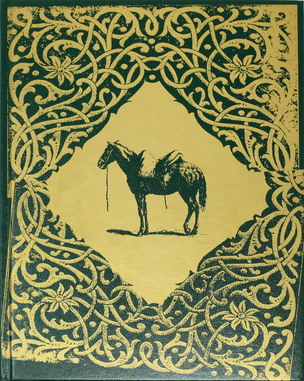Throughout the week of March 16th, 2020 in New York City—as flagship stores on Madison Avenue and throughout Soho were mothballed and gutted of merchandise in preparation for pandemic looting—hastily written messages of sympathy, panic and vulnerability were taped to their doors with the expectation of removal in a week or two. The letters reminded passersby that commerce never sleeps on the connected screens in their hands and in their homes and claimed this audience as “community”. Track lights in the spaces beyond the notes dimly accented empty racks. Shelves and vitrines full of nothing advertised only perfectly round pools of warm light. This modest illumination was just enough to backlight the printed sheets of copy paper affixed to the glass doors protecting all that absence, and at night they glowed divine.
In museums, the wall cards placed near artworks are called tombstones for their common responsibility of delineating the limits of an artist’s life. The glowing memos on the facades of the empty shops read like tombstones, floating before biennial-grade portraits of consumption—stripped to its skeletal architecture by crisis.
The goodbyes left by hypermediated brands—sharks in the 1.5 trillion-dollar global apparel market—were often set in Microsoft Office’s default ClearType font, Calibri. For the better part of five months, Alexander McQueen, Missoni, Moschino, Proenza Schouler, Hermes, Longchamp, Rolex, Lanvin, Chanel and Versace slummed it in Microsoft’s sweatpants for the printed page.
Nothing telegraphs luxury like a corporation with the confidence to settle for a default.
Deemed a pandemic essential worker, I was commuting between New York City’s Upper East Side and the Flatiron District every day of lockdown. When I first began posting to social media images and video of empty and boarded up shops—emphasizing the apologetic texts adhered to their doors—a friend involved in brand management at Supreme sent me a DM. He loved what had happened to corporate identity left to the devices of retail store managers.
Design, like criticism, art, and music, is availed of charming eccentricity beyond the oppressive constraints of theory, harmony, and the academy. Bring me the head of the Adobe Creative Cloud and of every typography professor who’s ever ranted about hyphenation-and-justification or indifference toward The Grid. Gen-X didn’t survive David Carson’s RayGun to stone a Chanel shop manager over force-justifying a couple paragraphs in Microsoft Word or leaving some hyperlinks underlined and colored blue. An anonymous employee unilaterally claiming the voice of a global brand like Chanel, without knowing what to give a fuck about, was the most democratic thing I’d seen in America in years.
The signs collected in Our Community are bootlegs reverse-engineered with looted materials. The vector graphic logos, fonts, and corporate color values are ripped and transcoded from the CSS and HTML of brand websites. The book’s facsimiles preserve the chaos and errors of their source in situ.
Our Community is a celebration of upside down logos, invalid social media accounts, underlined blue hyperlinks, forced justification, manic hyphenation, orphaned text, and irrationally sized message copy. It’s an anthology of corporate panic, tone deafness, and cognitive dissonance. Our Community is a love letter to brand vulnerability and a reminder that when the chips are down, your community will smash your windows and take what’s ours. - Visitor


















![Protect Me From What I Want Wooden Postcard [Gold Text]](https://d23eqwv5slm408.cloudfront.net/api/file/1rE09CiPQpGMa3jDySHP/convert?fit=max&h=480&w=304&compress=true&fit=max)
![Words Tend To Be Inadequate Wooden Postcard [Gold Text]](https://d23eqwv5slm408.cloudfront.net/api/file/HhtS8vASTpWSUA41En0s/convert?fit=max&h=480&w=304&compress=true&fit=max)

![All Things are Delicately Interconnected Wooden Postcard [Gold Text]](https://d23eqwv5slm408.cloudfront.net/api/file/muHR6MdRL6EgJe6ATC1m/convert?fit=max&h=480&w=304&compress=true&fit=max)

![Protect Me From What I Want Wooden Postcard [Red Text]](https://d23eqwv5slm408.cloudfront.net/api/file/xKZZfpWNQRChHZkrFntw/convert?fit=max&h=480&w=304&compress=true&fit=max)
![All Things Are Delicately Interconnected Wooden Postcard [Red Text]](https://d23eqwv5slm408.cloudfront.net/api/file/C6N6ppL6SnKYeXJuCtbd/convert?fit=max&h=480&w=304&compress=true&fit=max)







![In a Dream You Saw a Way to Survive and You Were Full of Joy Wooden Postcard [Black Text]](https://d23eqwv5slm408.cloudfront.net/api/file/WEd4Y05lROcLsySIoRfJ/convert?fit=max&h=480&w=304&compress=true&fit=max)
![Raise Boys and Girls the Same Way Wooden Postcard [Red Text]](https://d23eqwv5slm408.cloudfront.net/api/file/uV8m1BsaQ6OCflSE578g/convert?fit=max&h=480&w=304&compress=true&fit=max)
![Money Creates Taste Wooden Postcard [Black Text]](https://d23eqwv5slm408.cloudfront.net/api/file/FDyWtNrERsKaawMR4dY8/convert?fit=max&h=480&w=304&compress=true&fit=max)
![The Breakdown Comes When You Stop Controlling Yourself and Want the Release of a Bloodbath Wooden Postcard [Black Text]](https://d23eqwv5slm408.cloudfront.net/api/file/Yq72qCUcTzenjZPmDHHH/convert?fit=max&h=480&w=304&compress=true&fit=max)

![Expiring for Love is Beautiful But Stupid Wooden Postcard [Red Text]](https://d23eqwv5slm408.cloudfront.net/api/file/PT3j9ljKSpS25IO8wycY/convert?fit=max&h=480&w=304&compress=true&fit=max)
![You Are Guileless In Your Dreams Wooden Postcard [Red Text]](https://d23eqwv5slm408.cloudfront.net/api/file/ZK3xDij0TaSAYgCc33sM/convert?fit=max&h=480&w=304&compress=true&fit=max)


![Money Can Buy You Love [Postcard]](https://d23eqwv5slm408.cloudfront.net/api/file/xZZhOmzTJiMu3SC7vLlT/convert?fit=max&h=480&w=304&compress=true&fit=max)


![To Buy Or Not To Buy [Postcard]](https://d23eqwv5slm408.cloudfront.net/api/file/OHBW6G4RGKh49ott8liS/convert?fit=max&h=480&w=304&compress=true&fit=max)

![Private Property Created Crime Wooden Postcard [Black Text]](https://d23eqwv5slm408.cloudfront.net/api/file/KI5UbFcfScGfPtZgAdYY/convert?fit=max&h=480&w=304&compress=true&fit=max)
![Untitled Film Still #21, 1978 [Postcard]](https://d23eqwv5slm408.cloudfront.net/api/file/aPsUudHwRDWz2SwOpwRg/convert?fit=max&h=480&w=304&compress=true&fit=max)
![Untitled [Business as usual] Tote Bag](https://d23eqwv5slm408.cloudfront.net/api/file/5dklHZepSsuX52IdaAV6/convert?fit=max&h=480&w=304&compress=true&fit=max)
















![2025 Slingshot Spiral Desk Organizer [Large]](https://d23eqwv5slm408.cloudfront.net/api/file/ZgnUiIyGQvCJckBO913B/convert?fit=max&h=480&w=304&compress=true&fit=max)
![2025 Slingshot Spiral Organizer [Small]](https://d23eqwv5slm408.cloudfront.net/api/file/KZ7ZLJgxSUOwmKWv37hA/convert?fit=max&h=480&w=304&compress=true&fit=max)







![Blue Moon Ari Marcopoulos T-Shirt [X-LARGE]](https://d23eqwv5slm408.cloudfront.net/api/file/uSvA0LwzRlC8ZekANYmI/convert?fit=max&h=480&w=304&compress=true&fit=max)
![Blue Moon Ari Marcopoulos T-Shirt [LARGE]](https://d23eqwv5slm408.cloudfront.net/api/file/RVRQRVnRQtujs9DmAyCs/convert?fit=max&h=480&w=304&compress=true&fit=max)
![Blue Moon Ari Marcopoulos T-Shirt [MEDIUM]](https://d23eqwv5slm408.cloudfront.net/api/file/v9V1Mlb3RfSvN9glBNMt/convert?fit=max&h=480&w=304&compress=true&fit=max)
![Blue Moon Ari Marcopoulos T-Shirt [SMALL]](https://d23eqwv5slm408.cloudfront.net/api/file/qtNAgHVcRaqHCzkAx5B2/convert?fit=max&h=480&w=304&compress=true&fit=max)
![2025 Slingshot Organizer [Pocket Classic]](https://d23eqwv5slm408.cloudfront.net/api/file/TvyPY1HQySS4aIlgwaK2/convert?fit=max&h=480&w=304&compress=true&fit=max)
